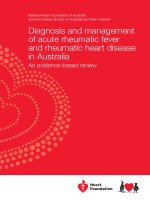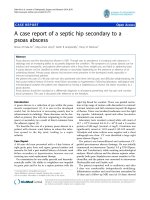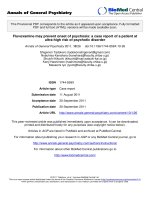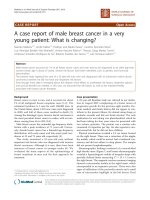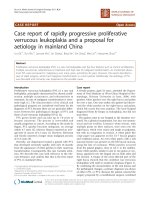A case report of dengue hemorrhagic fever complicated with diabetic ketoacidosis in a child: Challenges in clinical management
Bạn đang xem bản rút gọn của tài liệu. Xem và tải ngay bản đầy đủ của tài liệu tại đây (235.5 KB, 4 trang )
Thadchanamoorthy and Dayasiri BMC Pediatrics
/>
(2020) 20:403
CASE REPORT
Open Access
A case report of dengue hemorrhagic fever
complicated with diabetic ketoacidosis in a
child: challenges in clinical management
V. Thadchanamoorthy1 and Kavinda Dayasiri2*
Abstract
Background: Diabetic ketoacidosis (DKA) is a common presentation of type 1 diabetes mellitus (T1DM) precipitated
by various bacterial and viral infections. Dengue infection is no exception for this and can be a precipitating factor
for DKA. The presentation of DKA with dengue haemorrhagic fever (DHF) has been reported in adults. However, it
is very rarely observed in children.
Case presentation: We present the case of a paediatric patient who was previously healthy and subsequently,
developed polyuria (above 3 ml/kg/hour), irritability and high blood glucose (724 mg/dl) during the critical phase of
DHF. DKA was diagnosed with DHF and managed successfully with insulin and intravenous fluids. He recovered
without complications and discharged home with follow up being arranged at the endocrinology clinic.
Conclusions: When both DHF and DKA present together in a patient, meticulous monitoring of glycaemic control
as well as fluid management is required to reduce the potential risk for severe complications of both conditions.
Since there are no similar paediatric case reported in the literature, this case report might inspire paediatricians to
anticipate the possibility of DKA in children with DHF.
Keywords: DKA, Fluid therapy, DHF
Background
Dengue has a wide spectrum of clinical manifestations
which may be mild to severe and can be severe enough
to cause death due to dengue shock syndrome. Worldwide estimates suggest that annual incidence of dengue
fever and DHF has been 100 million and 500,000 respectively. Ninety percent of DHF cases are children
under 15 years old [1, 2]. Dengue fever similar to other
viral infections is known to precipitate diabetic ketoacidosis in patients with diabetes. Both insulin dependent
and independent diabetes can increase the release of
pro-inflammatory cytokines and intensify the risk of
plasma leakage in dengue fever. Acute pancreatitis is a
* Correspondence:
2
Base Hospital, Mahaoya, Sri Lanka
Full list of author information is available at the end of the article
rare complication of severe dengue infection, which
could be a contributory factor for diabetic ketoacidosis.
The clear understanding of the comorbidity and mortality between the two diseases is vital in patient management during acute illness.
There is only limited research evidence with regard to
actual fluid requirement during critical phase of dengue
haemorrhagic fever as plasma leakage is dynamic and
can occur at different rates across the critical phase [3].
Therefore, current practice of fluid management in DHF
depends, to a greater extent, on expertise of the managing clinicians and a number of assumptions regarding
evolution of plasma leakage. Urine output is considered
as a reliable indicator of haemodynamic stability in patients with DHF and maintaining urine output between
0.5–1 ml/kg/hour is considered appropriate to prevent
both shock and fluid overload that carry high risk of
© The Author(s). 2020 Open Access This article is licensed under a Creative Commons Attribution 4.0 International License,
which permits use, sharing, adaptation, distribution and reproduction in any medium or format, as long as you give
appropriate credit to the original author(s) and the source, provide a link to the Creative Commons licence, and indicate if
changes were made. The images or other third party material in this article are included in the article's Creative Commons
licence, unless indicated otherwise in a credit line to the material. If material is not included in the article's Creative Commons
licence and your intended use is not permitted by statutory regulation or exceeds the permitted use, you will need to obtain
permission directly from the copyright holder. To view a copy of this licence, visit />The Creative Commons Public Domain Dedication waiver ( applies to the
data made available in this article, unless otherwise stated in a credit line to the data.
Thadchanamoorthy and Dayasiri BMC Pediatrics
(2020) 20:403
mortality. However, it is crucial that clinicians are mindful of potential confounding factors such as hyperglycemia. As a patient with dengue fever presents with
hyperglycemia, urine output becomes an unreliable indicator of haemodynamic status and patient might have
polyuria even during shock [4]. We report a child who
was initially admitted for dengue fever and subsequently
developed DHF associated with polyuria and irritability
needing more fluids to maintain vital signs during the
critical period of DHF. He was ultimately diagnosed as
having type − 1 diabetes mellitus associated diabetic
ketoacidosis with DHF. The report enlightens the importance of consideration of differential causes for surprisingly high urine output in patients with DHF
associated shock and clinical decision making based on
meticulous overall haemodynamic assessments. Management of this patient would be a thought-provoking and
challenging task for clinicians and their teams.
Case presentation
A 13-year-old previously healthy boy was admitted with
fever, generalized body ache, headache, cough and mild
diarrhea for 4 days and abdominal pain and vomiting for
2 days. His urine output was satisfactory. Dengue NSI
antigen done on day 3 febrile illness was positive. He
had no history of thirst, weight loss, and increased frequency of urination. On examination he was febrile
(99.5F), ill looking, and flushed but was rational and heamodyanamically stable. Blood pressure had been 100/70
mmHg with pulse pressure of 30 mmHg. Pulse was of
good volume and rate had been 155 / minute. His
Complete Blood Count showed leukopenia (WBC- 1.5 ×
103/ cumm), and thrombocytopenia (platelet count 100 × 103/cumm). Haemoglobin was 13 g/dL, and haematocrit was 38. Random blood glucose on admission was
104 mg/dl. Abdominal examination showed 3 cm hepatomegaly and there was no clinical evidence of pleural
effusion. He was provisionally diagnosed as having DHF
and haemodynamic monitoring was commenced while
he was on oral rehydration fluids at rate of 75 ml per
hour. The child tolerated oral rehydration fluids well
and did not need intravenous fluids including dextrose
solutions.
On day five, he started to deteriorate with low volume
pulse, tachycardia (rate of more than 180/min), cold
clammy extremities and narrow pulse pressures whilst
on intravenous 0.9% saline (4 ml/kg/hour) and oral fluids
(1 ml/kg/hour). Clinical examination of lungs showed
slight reduction of air entry on right side with vesicular
breathing and no added sounds were heard. However,
his urine output remained surprisingly satisfactory (more
than1.5 mL/kg/hour). In addition, he became more irritable, thirsty, tachypnoic and had severe generalized abdominal tenderness whilst on two units of 0.9% saline
Page 2 of 4
10 mL/kg boluses followed by 5 mL/kg/hour infusions.
He continuously had disproportionately increased urine
output (more than 2 mL/kg/hour) and pulse pressure
varied between 15 to 20 mmHg. His Complete Blood
Count showed WBC - 4.5 × 103 (N− 60%, L-34%), haemoglobin - 16 g/dL, platelets - 60x103mm/l, and haematocrit - 48. C-reactive protein (CRP) was elevated (12 mg/
dl). Renal functions (Na- 140 mmol/L, K-4.3 mmol/L,
serum creatinine 0.9 mg/dl) were normal apart from
raised blood urea (60 mg/dL). Liver functions were
deranged (Alanine transaminase − 240 IU/L, Aspartate
transaminase-546 IU/L). Serum amylase was normal (44
U/L) Chest X-ray was normal apart from mild haziness
all over the lungs. Ultrasound revealed mild ascites and
bilateral pleural effusions. Capillary blood glucose was
724 mg/dl. He was transferred from local hospital to intensive care unit (ICU), in the tertiary care hospital for
further management of diabetic ketoacidosis cooccurring with DHF. As he had high fever with unstable
haemodynamic parameters and CRP was elevated, he
was commenced broad spectrum empirical intravenous
antibiotics. However, antibiotics were stopped following
negative blood cultures.
In ICU, he had moderate to severe metabolic acidosis
with arterial blood gas showing pH -7.17, pCO2-23
mmHg, pO2- 75 mmHg, HCO3- 12mmo/l and base excess-(− 14). Urine ketone bodies were positive. Blood ketones were not performed due to unavailability of this
investigation in the hospital. He was resuscitated with
dextran 40 with the dose of 10 ml/ kg once. Then he
was started 0.9% saline with soluble insulin infusion at
0.1 u/kg/hour and blood glucose was monitored hourly
until glucose levels dropped between 200 and 328 mg/dl.
Intravenous fluid (0.9%saline) was adjusted between 5
and 7 ml/kg/h depending on the vital signs. We did not
administer intravenous dextrose as it might have worsened hypovolaemia by the ongoing plasma leakage, producing more hydrostatic pressure and also producing
osmotic diuresis. Instead child was advised to take foods
which contained complex carbohydrate. Fluids were adjusted hourly according to pulse pressure which was
more than minimum 20 mmHg and capillary refilling
time was maintained below 2 s. The management was
not guided both by urine output which had been more
than expected and pulse rate due to presence of high
fever. In addition, potassium was added to fluids as
serum electrolyte revealed Na-140 mmol/L, and K-3.0
mmol/L while on insulin. As he improved after 24 h of
critical period, his fluids and insulin were reduced to
half. He was not commenced intravenous bicarbonate as
repeat arterial blood gas showed improved findings (pH
7.32, PCO2-30 mmHg, PO2-80 mmHg, HCO2–18, Base
excess (− 8)) following correction of dehydration and
glucose with insulin. The lowest platelet count was
Thadchanamoorthy and Dayasiri BMC Pediatrics
(2020) 20:403
12x103and renal function had been within normal range
on the day 6 of illness. Intravenous Insulin was changed
to subcutaneous insulin after 48 h of critical period and
urine ketone bodies were noted to be negative.
After 72 h of ICU care, he was transferred to medical
ward where he was continued on subcutaneously insulin
and food according to dietician’s advice. Blood glucose,
urine ketone body, renal functions, liver functions and
hematological parameters were repeated until they were
normalized. His HbA1C was 5.1% and Glutamic acid decarboxylase autoantibody had been positive (22 IU/L).
Other type 1 diabetes related autoantibodies could not
be performed due to limited financial resources in patient’s family. Both IgM and IgG dengue antibodies were
positive on day 7 and dengue infection was notified to
infection control team of the local hospital. Intravenous
antibiotic was discontinued after 5 days with normal
CRP. He was discharged after 2 weeks of hospital stay
with the postprandial blood sugar being 146 mg/dl and
fasting blood sugar being 100 mg/dl. Follow up was arranged at the endocrinology clinic. He was reviewed
after 6 months and 1 year in the paediatric clinic and
found to have been in good health and HbA1C was
within normal range (5.3–5.5%). He is currently on insulin pump therapy under the care of paediatrician, paediatric endocrinologist and dietician. His growth and
school performance had been within normal limits at
one-year follow up.
Discussion and conclusions
We report the case of this young boy who was initially
admitted with dengue fever but subsequently developed
DKA during the critical period of DHF. The rarity of this
co-incidence in the paediatric age group and unexpected
challenges in management of this child might inspire
paediatricians. Altered haemostasis and plasma leakage
have been two important pathophysiological mechanisms in DHF. Vascular leakage is caused by a transient
increase in vascular permeability due to endothelial dysfunction and subsequent occurrence of haemoconcentration. The elevation of hematocrit greater than 20% is
typically used as a cut-off to define the presence of leakage in dengue [5]. In patients with vascular leakage, excess intravenous fluid therapy can aggravate fluid
accumulation and precipitates respiratory distress while
substandard fluid treatment can cause shock. The osmotic diuresis in DKA results in large volume depletion.
Typical total body water deficit among patients with
DKA is 100 mL/kg of body weight, and the deficit becomes even higher with fluid loss in the phase of fluid
leakage in DHF. Therefore, continuous monitoring and
careful use of intravenous fluids are crucial in the management of patients with both DHF and DKA. The initial fluid therapy would be isotonic solutions to maintain
Page 3 of 4
satisfactory tissue perfusion and urine output should be
at least 0.5 mL/kg/hour whilst insulin infusion is running. Intravenous fluids can be reduced gradually when
plasma leakage decreases towards the end of the critical
period which is usually signposted by an increase in
urine output or decrease in hematocrit [6]. The reported
child developed DKA during the critical period of DHF.
We followed combined national and international guidelines for management of DKA and DHF. We managed
the child with isotonic fluids and dextran 40 to restore
the hypovolaemia. In addition, we were also guided by
previous reports of dengue presenting with diabetes in
adults [4, 7] as we could not find any reported cases in
children. Literature reported in adults had been mainly
dengue infection diagnosed in patients with insulin independent diabetes mellitus (type 2).
DHF was considered as a trigger factor for DKA in this
patient who had previously undiagnosed diabetes mellitus. There were few case reports of dengue triggering
diabetic ketoacidosis [4, 7, 8]. Supradish et al. reported
the case of a 16-year-old Thai girl who presented in dengue shock showing signs of severe dehydration and ascites [7] and one other review article reported that those
who had diabetes were two and half times as likely to
have dengue hemorrhagic fever [9] The physiopathology
of dengue hemorrhagic fever leads to amplification of
the immune response following presence of heterotypic
antibodies against a serotype of the dengue virus at the
time of new infection [10]. Thus Type 1 diabetes mellitus is commonly associated with autoimmunity and the
immune system may be persistently activated with signs
of inflammation in tissues and capillaries, and is more
likely to lead to inflammation and liberation of proinflammatory cytokines in tissues, particularly in the
endothelium, explaining the higher risk of plasma leak
in dengue fever [11].
Although ideal total body water deficit is 100 mL/kg in
children with severe DKA, the actual deficit increases
more than ideal deficit in the presence of fluid leakage.
Both DHF related shock and fluid deficit due to DKA
were managed in this patient with 0.9% saline with frequent monitoring of blood glucose, blood gases and
haemodynamic parameters including pulse rate, and
pulse pressure. Fluid intake was adjusted to keep urine
output at least 0.5 mL/kg/hour and pulse pressure at
least 20 mmHg. Early recognition of DKA and DHF are
crucial in preventing complications related to both
conditions.
The reported patient had hypovolaemia with surprisingly high urine output during the critical phase of DHF
due to concurrent DKA. This situation in critical phase
of DHF made fluid management more difficult even with
central venous pressure monitoring. Fluids were adjusted
every hour with insulin dose until the child reached
Thadchanamoorthy and Dayasiri BMC Pediatrics
(2020) 20:403
recovery phase with meticulous blood glucose monitoring. As the reported child tolerated food well, cooperated with the management and was conscious throughout
the critical period, he made a rapid and complete recovery of both complications without needing invasive
monitoring. Meticulous non-invasive monitoring in the
intensive care needed more human resources and added
more mental stress to clinicians and their team who
treated this child.
We further could not use any invasive monitoring to
adjust the fluid management as his platelet had been low
although invasive monitoring was available in the tertiary care hospital. This was another challenge the clinicians faced during fluid management as he had a high
chance of internal bleeding while inserting the central
cannulas. Fortunately, the child did not have bleeding at
any time of illness and non-invasive monitoring sufficed.
As this patient was admitted to local hospital where patient had been managed with limited facilities including
human resources, timely diagnosis of coexisting diabetic
mellitus was a challenge in the management of this child
and possibly contributed for a delay in transfer to the intensive care unit. However, the diagnosis of diabetic
ketoacidosis was made without much delay, and the
child improved without developing any unacceptable
complications. The authors recommend that urine output should be carefully reviewed in all patients with
DHF on individual basis and differential causes for discordant urine output should be identified and managed
without delay to prevent complications.
Dengue can rarely present with various atypical endocrinological manifestations in children. Every clinician
must anticipate DKA in children with disproportionately
high urine output during dengue infection even though
it is rare in children. Scrupulous and frequent monitoring is an important step in identifying co-morbidities
and treating these children. We were channeled with
contradicting findings of urine output and vital parameters to make the diagnosis successfully.
Abbreviations
DHF: Dengue haemorrhagic fever; DKA: Diabetic ketoacidosis; ALT: Alanine
transaminase; AST: Aspartate transaminase; HbA1C: Haemoglobin A 1C;
ICU: Intensive Care Unit; BU: Blood urea
Acknowledgements
We would like to thank Dr. K. Dharshini, Consultant Endocrinologist, and Dr.
N. Yogananth, Consultant Anaesthetist.
Authors’ contributions
VT led clinical management of the patient and wrote manuscript. KD
performed literature survey, wrote and edited the manuscript. Both authors
read and approved final version of the manuscript.
Funding
No funding was received.
Page 4 of 4
Availability of data and materials
The data that support the findings of this case report are available from
Medical Records Department, Batticaloa Teaching Hospital, but restrictions
apply to the availability of these data, which were used under license for the
current report and so are not publicly available. Data are, however, available
from the authors upon reasonable request and with permission of Medical
Records Department, Batticaloa Teaching Hospital, Sri Lanka.
Ethics approval and consent to participate
Not applicable.
Consent for publication
Written informed consent was obtained from patient’s legal guardian for
publication of this case report. A copy of the written consent is available for
review by the Editor-in-Chief of this journal.
Competing interests
The authors declare that there is no conflict of interests regarding the
publication of this paper.
Author details
1
Faculty of Health Care Sciences, Eastern University, Batticaloa, Sri Lanka.
2
Base Hospital, Mahaoya, Sri Lanka.
Received: 28 April 2020 Accepted: 17 August 2020
References
1. Malavige GN, Fernando S, Fernando DJ, Seneviratne SL. Review Dengue
viral infections. Postgrad Med J. 2004;80:588–601. />pgmj.2004.019638.
2. Kularatne SA. Dengue fever. BMJ. 2015;351:h4661. />bmj.h4661.
3. Kularatne SA, Weerakoon KG, Munasinghe R, Ralapanawa UK, Pathirage M.
Trends of fluid requirement in dengue fever and dengue haemorrhagic
fever: a single centre experience in Sri Lanka. BMC Res Notes. 2015;8:130.
Published 2015 Apr 8. />4. Dalugama C, Gawarammana IB. Dengue hemorrhagic fever complicated
with transient diabetic ketoacidosis: a case report. J Med Case Rep. 2017;
11(1):302. Published 2017 Oct 28. />5. Srikiatkhachorn A, Spiropoulou CF. Vascular events in viral hemorrhagic
fevers: a comparative study of dengue and hantaviruses. Cell Tissue Res.
2014;355:621–33. />6. World Health Organization. WHO Guidelines Approved by the Guidelines
Review Committee. In: Dengue: Guidelines for Diagnosis, Treatment,
Prevention and Control: New Edition. Geneva: WHO Press; 2009. p. 1–144.
7. Supradish PO, Rienmanee N, Fuengfoo A, Kalayanarooj S. Dengue
hemorrhagic fever grade III with diabetic ketoacidosis: a case report. J Med
Assoc Thail. 2011;94:0–40.
8. Kitabchi AE, Umpierrez GE, Murphy MB, Kreisberg RA. Hyperglycemic crises
in adult patients with diabetes. A consensus statement from the American
Diabetes Association. Diabetes Care. 2006;29:2739–48. />2337/dc06-9916.
9. Figueiredo MA, Rodrigues LC, Barreto ML, et al. Allergies and diabetes as risk
factors for dengue hemorrhagic fever: results of a case control study. PLoS
Negl Trop Dis. 2010;4(6):e699. Published 2010 Jun 1. />journal.pntd.0000699.
10. Halstead SB. The pathogenesis of dengue: molecular epidemiology in
infections disease. Am J Epidemiol. 1981;114(5):632–48. />1093/oxfordjournals.aje.a113235.
11. Brown JM, Wilson TM, Metcalfe DD. The mast cell and allergic diseases: role
in pathogenesis and implications for therapy. Clin Exp Allergy. 2008;38(1):4–
18. />
Publisher’s Note
Springer Nature remains neutral with regard to jurisdictional claims in
published maps and institutional affiliations.
